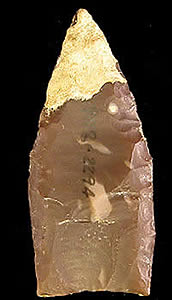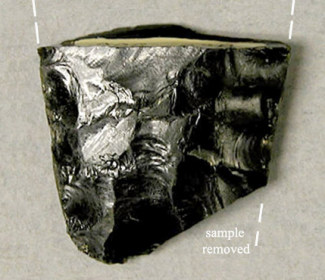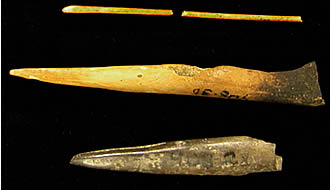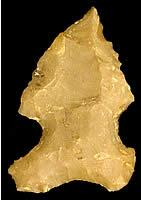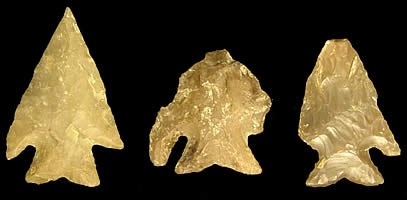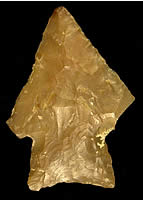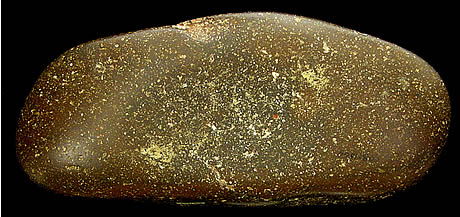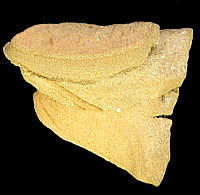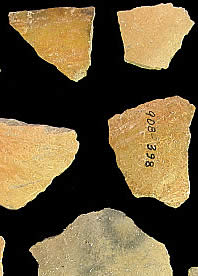|
Over the millennia, hundreds of people
stayed in Kincaid Shelter, using the protected locale
as a base for hunting animals, gathering plants, nuts
and seeds, making tools, refurbishing gear, and carrying
out other tasks of daily life. Others may have merely
stopped there overnight during a longer journey. Like
their modern counterparts, many of these prehistoric
campers left behind a scattering of trash as well as
a few more meaningful items that perhaps were lost or
forgotten in the shelter's recesses.
Yet what was trash to prehistoric and
later peoples often holds special significance to researchers
today. Even broken or spent weapons carry important
technological and stylistic information which helps
researchers understand life in the past. Discarded tools
and toolmaking debris provide insights into the technologies
and economies of the various prehistoric visitors. Animal
bones inform researchers about the prehistoric diet
and may indicate changes in climate and the environment
over time.
Unfortunately more than half of the artifacts
recovered from Kincaid have no precise provenience,
that is, they were out of place, having been dug up
and discarded by treasure-hunters. Since the diggers
were searching for gold and silver, they left the Indian
artifacts behind in their backdirt piles. Prehistoric
peoples churned the shelter deposits as well, perhaps
digging pits into lower levels for hearths and, in the
process, displacing and mixing items left by earlier
visitors. For these reasons, many of the items from
the shelter cannot be connected to a particular cultural
group or time period.
In this section we present a gallery of
selected artifacts from Kincaid Shelter curated in the
TARL Collections. While investigators did not collect
or document all the items they encountered, as is the
more standard practice today, they did recover a meaningful
sample that provides a window into past activities and
peoples at Kincaid. The artifacts have yet to be fully
analyzed and reported, although T. N. Campbell did a
preliminary classification as part of an unpublished
report on Kincaid. Michael Collins and Gene Mear inventoried
and measured many of the chipped stone items in the
collection, and Collins did a more in-depth study of
the Paleoindian materials. Parts of these data are used
in descriptions below and in the Kincaid
Revisited section, which details Collins findings.
Weapons and Tools
|
|
In This Section:
|
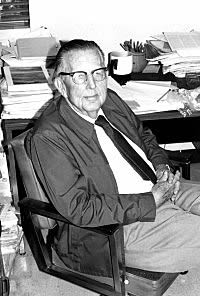
The late T.N. Campbell, professor
of anthropology at the University of Texas at
Austin, classified most of the Kincaid artifact
collection and, with Glen Evans, wrote up the
findings from the site. The report was never completed
or published. Archeologist Mike Collins, working
with Gene Mear, took over the effort in 1988.
Collins took this photo.
|
| |
|
|

Five Folsom points were recovered from
treasure hunters' backdirt piles at Kincaid. The fluted
points are a distinctive "signature" of the Folsom culture,
bison-hunters and gatherers who roamed the North American
Plains roughly 12,000 years ago. Dots on drawings indicate
extent of grinding on lateral edges (from the bases). TARL
Collections. Photos by Aaron Norment; drawings by Hal Story.
Click on photos to enlarge and see reverse views.
|
|
A resharpened point
found in a backfill pile. Its tip is partially coated
with travertine (calcium carbonate), indicating it originally
derived from Late Pleistocene deposits. The flutes on
both faces (sides) were from multiple blows. Collins
has identified it as a Clovis point . Photo by Aaron
Norment.
|
This fragmentary Paleoindian
point base is made of a particular type of obsidian
which occurs only in Querétaro, Mexico, more
than 600 miles to the south. It was found in the Clovis-era,
Zone 4 deposits. It cannot be confidently assigned to
a particular point type, although it bears some similarities
and presumed affinities to Clovis. The right corner
was removed for sourcing analysis. Click to enlarge
and see drawings of unaltered specimen. Photo by Araon
Norment.
Click images to enlarge
|
A distinctive polyhedral
core, from which a Clovis knapper removed a series of
long, parallel-sided flakes (blades), was found in Zone
4. The blades could either be used as tools for cutting
and slicing or could be knapped further and shaped into
bifaces, projectiles, and other tools. Photo by Aaron
Norment.
|
|
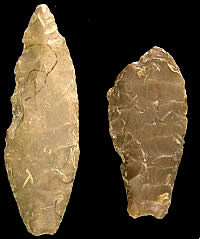
Angostura points. This style
of lanceolate dart tip was made during very Early
Archaic times some 9000 years ago. Some often
have fine, parallel flaking. Photo by Aaron Norment.
Click to enlarge and see more examples.
|
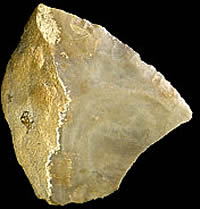
A simple flake is an effective
cutting tool. This specimen was recovered from
Zone 4 Late Pleistocene deposits. Photo by Aaron
Norment.
|
|
Prehistoric toolmakers used many different
tools and a variety of resources in their work. From
stone, bone, leather, sinew, shell, and plant fibers,
these early craftsmen created weapons and tools, baskets
and mats, grinding implements, clothing and sandals,
ornaments, and works of art. Few perishable materials
survived the damp conditions at Kincaid. We know from
other sites in the more-arid western regions, however,
that items of wood, fiber and other organic materials
would have made up the bulk of prehistoric hunting and
camping gear.
Chipped stone tools constituted the great
majority of artifacts at the shelter, including projectile
points, scrapers, knives, perforators, adzes, and a
variety of toolmaking gear and chipping debris. Prehistoric
stone knappers would have used rounded hammerstones
as well as bone and antler batons to remove flakes from
larger pieces of chert (flint) or other stone suitable
for flaking. Sharp-edged flakes derived from this process
made efficient cutting tools in themselves, or could
be chipped further and finished using finer tools, such
as antler tines. For other tasks, chipped stone burins
or gravers may have been used both for cutting and grooving
bones and for ornamental incising.
Bone tools such as these may have
been used for weaving plant strips into matting and
for leather working. The thin polished bone shown at
top is a needle, likely used in sewing.
|

Perforators, some of which
were made on the bases of gouges (lower left)
or projectile points (lower right), were found
throughout the deposits, and would have been used
for drilling or punching holes in wood or leather.
|
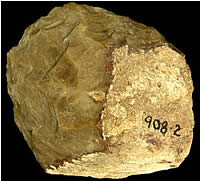
A heavy chopper such as this
one may have been used for cutting or pulverizing
fibrous plants.
|
|
|
|
An Early Archaic Merrell
point.
|
Early Archaic Martindale
points are distinguished by an expanding "fishtail"-shaped
base.
|
This heavily worn
Bell point was one of only a few points associated with
the Middle Archaic period. In pristine condition, it
would have had long barbs extending to its base.
|
|
|
Pedernales knives? This series of Late
Archaic Pedernales points shows the changes in shape that
occurred with use, as their edges were worn down and then
resharpened. Archeologist Mike Collins believes the points
may have been recycled and used as knives after they were
no longer serviceable as projectile points. Photo by Aaron
Norment. Click to see closeup example of resharpening.
|
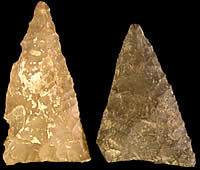
"Early Triangular"
dart points typical of the latter point of the
Early Archaic.
|

Several Late Archaic Montell
points indicate a type of use and reworking which
reduced them vertically, rather than laterally,
as in the case of the Pedernales "knives" shown
above. Projectile points often show impact or
snap fractures (including missing tips), caused
by striking an object (such as an animal), which
removed the tips. After such incidents, hunters
reworked points to create a new tip, but reduced
the overall size in the process. Click to see
more.
|

Arrowpoints, signaling the
shift to bow and arrow hunting technology about
1000 years ago, were found chiefly in the uppermost
layers. A variety of types are shown, including
Perdiz points (specimens A-L) that were part of
the tool kit likely used by buffalo hunters, roughly
700 years ago. Drawings by Hal Story.
|
|
Campbell identified almost 50 types of
projectile points from Kincaid, including dart points
and arrow tips. These diagnostics, or time markers,
span almost all known cultural intervals in the region.
A number of projectile points may have
served multiple purposes. For example, archeologist
Mike Collins believes that many Pedernales points—a
ubiquitous Late Archaic type found across much of central,
south, and west Texas—were recycled for use as
knives, judging from many specimens which have been
worn down and resharpened repeatedly along their lateral
edges. Several have been reduced to an almost lanceolate
form with no barbs or shoulders remaining, as shown
in the above photo.
In contrast, the series of later Montell
points shown at left (in the enlarged image) suggests
more predominate use as projectile points. This type
of use typically causes vertical reduction in size.
For instance as points were fractured on the tip or
snapped on impact, they were reworked to create a new
tip of a shorter point.
One unusual Paleoindian projectile point base recovered
from Zone 4 is made of obsidian, a type of black volcanic
glass that rarely occurs naturally in Texas. It is lanceolate
in form with a contracting base; both sides have been
flaked in parallel patterning. Although the morphology
of this point is enigmatic, its Late Pleistocene context
suggests an early type, such as Clovis. Trace element
analysis on a small fragment of the base indicated the
material derived from a geologic source in Queretaro,
Mexico, roughly 620 miles (1000 km) to the southwest.
According to archeologist Thomas R. Hester, who coordinated
the obsidian study, Paleoindian projectile points made
of obsidian are rare in Texas.
Campbell lists almost 100 cores of several
different types in the Kincaid inventory, including
several blade cores. One small, nearly expended, polyhedral
blade core was found in Zone 4 and is attributed to
Clovis peoples. The remaining blade cores from Zones
5 and 6 probably were made by Late Prehistoric Toyah
folk, who also used blade technology to make their tools
and weapons.
|
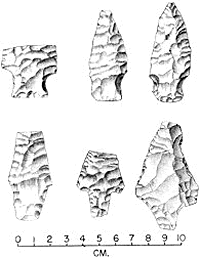
Middle and Late Archaic points
identified by T. N. Campbell and drawn by Hal
Story. Top row, Nolan. Bottom row (l-r), Nolan,
Langtry, Almagre. The alternately beveled stem
is a characteristic technical attribute of the
Middle Archaic Nolan type. Almagre likely is an
unfinished preform, or early stage, of a point
such as Langtry.
|
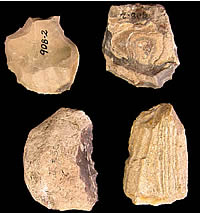
Flakes with trimmed edges,
serrations, and graver points likely made good
tools for hideworking, plant processing, and other
tasks.
|

Scrapers and gravers for a
multitude of purposes. The sharp points on the
tools (gravers) in the bottom three rows could
engrave shell or bone ornaments and stone pebbles.
Drawing by Hal Story.
|
|
|

Late Archaic points or knives, known as
Kinney type, illustrate the progression of wear and attrition,
as the edges are worn down and they are resharpened repeatedly.
Because of the flute-like, vertical flake removals from the
base, Kinneys have been mistaken for Paleoindian points. Drawings
by Hal Story.
Woodworking and Other Tasks
|
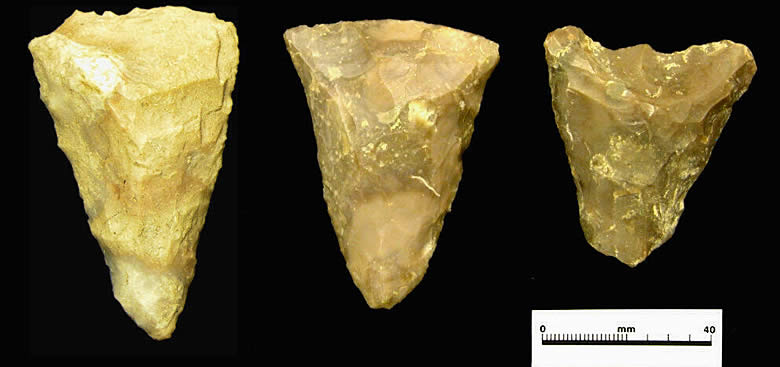
Examples of unifacial Clear Fork tools.
The specimens at left and center, from midden deposits (Zone
6), were probably used in an adze-like fashion to shape bone
or antler tools, based on a distinctive polish detected during
microscopic examination of the bits (the wider, beveled ends).
The stone tools would have been mounted in a wood or bone
haft to facilitate use. Photo by Aaron Norment.
|

Bifacial Clear Fork tools are
flaked on both sides, but have a beveled working
edge on one face. It is not known whether there
were different uses for bifacial and unifacial
forms of the tools, but there does seem to be
a difference in their ages. Although the specimens
shown were recovered from undatable backdirt piles,
bifacial Clear Forks from other sites were found
in early contexts and associated with Paleoindian
and Early Archaic points ( for example, the Wilson-Leonard
and Baker Cave sites). Photo by Aaron Norment.
|
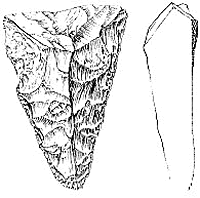
A unifacial Clear Fork Tool
that has been rejuvenated after the bit (upper)
end was removed. As the tools were used, the bits
became more steeply beveled and less effective.
Knocking the bit off provided a fresh edge with
a very sharp, acute angle. Several broken ends
and bases were found at Kincaid. Sketches by Pam
Headrick.
|
|
Several types of bevel-edged tools, or
adzes, used in woodworking, boneworking, and perhaps
hide scraping, were recovered from Kincaid. One type,
known as Clear Fork tools or gouges (because of their
initial classification at sites near the Clear Fork
of the Brazos River in northwest Texas), encompasses
both bifacial (chipped on both sides) and unifacial
(chipped on only one side) forms used by prehistoric
peoples from Paleoindian to Late Archaic times. Another
type, termed Guadalupe tools because of their predominate
distribution in the Guadalupe River basin of south Texas,
are long, thick, and rounded with a sharply truncated
bit (or working) end. At other sites, these tools have
been found chiefly in Early Archaic contexts. More than
25 Guadalupe tools were found at Kincaid.
Prehistoric workers put these tools to
heavy use, as is evidenced by battering and wear on
the bits and by the reworking and gradual attrition
of the tools. Tool bits broke off during use or were
deliberately knocked off and re-sharpened by the workers
to create a fresh, more acute-edged, and more effective
working end, as is illustrated in the example above.
The specimen at right has been reduced by use and/or
successive resharpenings to a size roughly half that
of most of the other specimens.
UT-Austin archeologist Dale Hudler examined
40 of the 45 Clear Fork tools from Kincaid in 1996 as
part of a larger study to try to determine usage of
195 tools of this form. Microscopic analysis of the
bits, or beveled-edged ends, of the tools showed polish
and striations which was then compared to that on replica
tools used in a variety of experimental uses. Six Kincaid
specimens (one bifacial and five unifacial) had a distinctive
"smooth, linear polish" on the bit which Hudler
correlated with use on a very hard contact material,
such as bone or antler.
Hudler also determined that the unifacial
Clear Fork tools from Kincaid tended to be wider than
most others in the statewide study. However, variations
in shape, size, and bit end morphology of both unifacial
and bifacial Clear Fork tools have not yet proven to
be meaningful. More likely, these differences in morphology,
particularly in length dimension, simply reflect use
and resharpening.
|
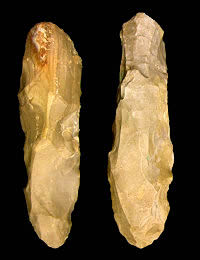
These long, narrow, bevel-edged
Guadalupe tools were likely used for woodworking.
They are found almost exclusively in South Texas
sites, particularly within the Guadalupe River
basin . Photo by Aaron Norment. Click to see more
examples.
|
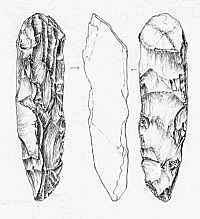
Drawing of a Guadalupe tool
from Kincaid, showing shape and angle of the bit
(upper) end and overall flaking. Illustration
by Pam Headrick.
|
|
|
Grinding and Milling Implements
Pecked and ground stone milling tools
were not common at Kincaid. The inventory consists of
three complete grinding slabs, or metates, four
fragments, and some 45 handstones, or manos.
With few exceptions, all were found in Zone 5 or are
unprovenienced.
The metates are worn; one shows use in
a back and forth motion, another in a circular motion.
A third has a circular basin that is roughly pitted.
The manos showed a variety of wear, including
grinding facets and striations, while others had central
pits, or slight depressions. These pitted specimens
may have been used as anvils, or platforms, for cracking
nuts. Many manos showed combinations of wear patterns.
Perhaps prehistoric cooks used these tools
for multiple purposes: a handstone for grinding seeds
and other foods, a platform for cracking nuts, and as
a surface for cutting fibrous materials, meat, or hide.
(Other examples of possible cutting platforms are shown
in Mysterious Stones section.)
|

Striations, stains and polish
cover this odd limestone tool that may have been
used for a variety of purposes, including grinding.
The striations, or cut marks, in the central pit,
suggest that a soft material may have been cut
on top of the stone. There are also pecks in the
depression, perhaps from pounding nuts. ( See
detail.) Click to enlarge. Photo by Aaron
Norment. |

Examples of grinding implements
from Kincaid. The shallow limestone metate, or
grinding slab fragment, at top has been worn down
from heavy use. The fragment is roughly 12 inches
(30 cm) in length. Manos, or handheld stones,
such as those at bottom, would have been used
to grind seeds, nuts,and plant bulbs into a flour-like
meal.
|
|
Prehistoric peoples must have
hauled this heavy cobble many miles to bring it
to the shelter. More than 12 inches (30 cm) in
length, the stone is basalt, or poryphry, a fine-grained
volcanic material that does not occur locally
but is found naturally in the Central Mineral
region (Llano Uplift) to the northeast. Highly
polished, the stone is also scratched and pitted
on one face, as if it had been used in grinding.
There are also small patches of red ocher stain,
indicating it may have been used to pulverize
pigment. Quite likely, this unusual artifact was
used in many different ways. Click to enlarge.
|
|
Ornaments and Special Objects
|
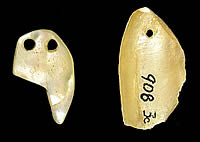
Ornaments made of freshwater
mussel shell may have been suspended on cording
and worn as jewelry. The object on left was from
Archaic levels in a terrace test pit, the one
on right from disturbed fill. Photo by Aaron Norment.
|
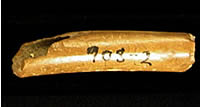
A polished, hollow bird bone has been grooved
and snapped on one end, perhaps to make a bead.
Bone beads strung on fiber cords have been found
in other sites, particularly in the dry shelters
of the Lower Pecos region.
|

This drawing of a grooved and snapped bird bone bead shows faint sets of lines decorating the object. Drawing by Hal Story. |
|
A number of objects from Kincaid were
less utilitarian and practical than stone tools and
weapons. Along with a quantity of engraved stones and
paint-making materials (see Mysterious Stones
section), there were several artifacts of shell and
bone likely worn for personal adornment as well as fragments
of a probable steatite pipe.
Two pendants made of very thin, freshwater
mussel shell had conical perforations drilled from the
concave surface of the shell. The objects may have been
worn suspended around the neck as jewelry. There were
also several pieces of bone that appear to have been
beads. These hollow sections had been grooved and snapped,
and were likely strung on a cord as a necklace.
Generally, the collection of bone and
shell artifacts was scant, however, and this is doubtlessly
due to damp conditions in the shelter which took their
toll on these and other, even more perishable items
made of fiber and wood.
Eight fragments of a vessel made of soapstone
(steatite), shown at right, appear to be the remains
of a tubular pipe that, based on rim sections, was roughly
2.5 inches (6.4 cm) in diameter. Soapstone is a metamorphic
rock, a talc which occurs in both eastern and western
parts of the United States. When freshly mined, it is
soft and can be easily shaped with hand-held tools.
Tool marks can be seen on both the interior and exterior
of the Kincaid vessel. In Texas, natural deposits closest
to the site are in Hudspeth county to the west, or in
the Llano Uplift, some 65 to 100 miles northeast of
the Kincaid site.
|
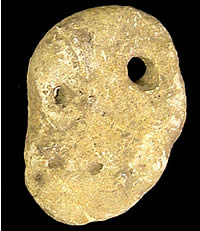
This limestone pebble may have
been worn as a pendant, with cording passed through
the hole cleanly drilled near one end. Photo by
Aaron Norment.
|

Curved fragments of a soapstone
(steatite) vessel perhaps once formed a long,
tubular pipe for smoking. The fragments were found
near the top of Zone 5 Archaic deposits. Photo
by Aaron Norment.
|
|
|
Pottery

This large rim
sherd had deeply scored lines across the exterior,
a technique perhaps used to make the vessel less
slippery if it was used to carry water. Photo
by Aaron Norment.
|
One of two
sandy textured sherds found at Kincaid. Photo
by Aaron Norment. Click to see full image.
|
|
Fragments of
thin-walled, bone-tempered pottery typically are
termed "Leon Plain."
|
During the late part of the prehistoric
period (roughly A.D. 1300), Kincaid occupants began
using pottery vessels to store food, water, and other
resources. Investigators found some 50 pottery sherds,
chiefly in the upper levels of terrace deposits in front
of the shelter. At least three different pottery types
are present, representing perhaps eight or nine different
vessels. These include thin-walled, bone-tempered sherds
(typically referred to as Leon Plain) and a thicker
version with vertical lines scored across the exterior
(cf., Boothe Brushed). Other sherds had a sandy texture
and apparent grog temper (crushed pottery sherds mixed
into the clay paste). Prehistoric potters used various
tempering agents, or additives, including sand, grit,
crushed shell, and bone, to improve the clay texture
and cause more even drying and firing.
Pottery-making technology was late to
catch on over much of what is now central and south
Texas. The Caddo villagers of east Texas made exceptional
pottery as early as 1000 years ago. The pottery at Kincaid
was made during the latter part of the Late Prehistoric
(Toyah interval, circa 400 to 700 years ago) and some
of it (the Leon Plain sherds) can be attributed to mobile
groups who used Perdiz arrowpoints and a distinctive
tool set associated with buffalo-hunting. Similar sherds
were identified at the nearby La Jita site.
|
|
Buttons and Bullets: Historic-Period Artifacts
|

More-recent visitors to Kincaid
left behind a variety of trash including bullets
and shells, construction materials, and broken
bottles. Photo by Aaron Norment.
|
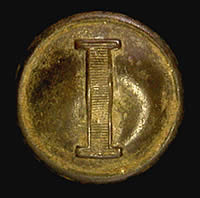
This brass button was identified
by Col. Marvin Crimmins of San Antonio as that
of a Confederate Infantry officer's jacket, as
signified by the letter "I."
|
|
A few historic-period artifacts were found
at Kincaid, indicating the presence of visitors—hunters,
fishermen, soldiers (or former soldiers), ranchers,
and picnickers—from the 1850s to modern times.
Along with a variety of ammunition, metal construction
materials, and glass, investigators found an 1857 half-dime
and a brass button from a Confederate infantry officer's
uniform. T.N. Campbell, in communicating with a militray
expert in San Antonio, learned that the button likely
is attributable to an officer on the staff of General
H.H. Sibley, who led a brigade through the area of Sabinal
in 1861 en route to New Mexico.
Ammunition found at the site included
cartridge cases bearing head stamps marked W.R.A. Co.
(Winchester Repeating Arms Co.) and variants, assignable
to the late 19th and early 20th centuries.
July 22, 1954
Dear Col. Crimmins,
I wonder if I might draw on your great store of military
knowledge for help in identifying a brass button found
in the top six inches of an archaeological site near
Sabinal. It appears to be from a military uniform. It
is 19.5 mm in diameter… . The top is convex and
has a loop for an attachment and is stamped "P.
Tait & Co., Limerick." Incidentally, at the
same level came a U.S. Half Dime, 1857…
Any light you may be able to throw on this button will
be much appreciated.
Sincerely yours,
T.N. Campbell, Chairman
|

An 1857 U.S. half-dime (both faces shown) was found by investigators in the upper layers of terrace deposits in front of the shelter. Photo by Aaron Norment. |
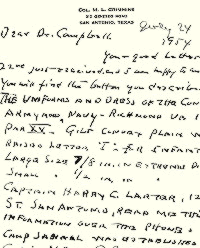
Letter from Col. Crimmins identifying
the brass uniform button found at Kincaid. Crimmins
noted that Confederate troops posted to Camp Sabinal
(near Kincaid Shelter) were not uniformed, therefore
the button may have dropped from the jacket of
troops in Gen. H.H. Sibley's brigade who passed
through Sabinal en route to New Mexico. The brigade
fought in a battle near Fort Craig in 1862. Click
to enlarge and read
full letter. |
|
|
| |





